Japanese battleship Ise
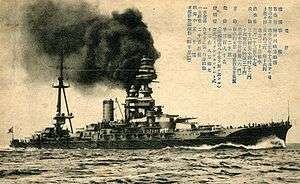 Ise | |
| History | |
|---|---|
| Name: | Ise |
| Namesake: | Ise Province |
| Ordered: | 11 April 1913 |
| Builder: | Kawasaki, Kobe, Japan |
| Laid down: | 10 May 1915 |
| Launched: | 12 November 1916 |
| Completed: | 15 December 1917 |
| Out of service: | 1945 |
| Struck: | 28 July 1945 |
| Fate: | Sunk by air attack, 28 July 1945 |
| Status: | Scrapped in place by 1947 |
| General characteristics (as built) | |
| Class and type: | Ise-class battleship |
| Displacement: | |
| Length: | |
| Beam: | 28.65 meters (94.0 ft) |
| Draft: | 8.93 meters (29 ft 4 in) |
| Installed power: |
|
| Propulsion: |
|
| Speed: | 23 knots (43 km/h; 26 mph) |
| Range: | 9,680 nmi (17,930 km; 11,140 mi) at 14 knots (26 km/h; 16 mph) |
| Complement: | 1,198 |
| Armament: |
|
| Armor: | |
Ise (伊勢(戦艦) Ise (senkan)), was the lead ship of the two-vessel Ise-class battleship of the Imperial Japanese Navy, which saw combat service during the Pacific War. Ise was named after Ise Province, one of the traditional provinces of Japan, now part of Mie Prefecture.
Operational history
Early history
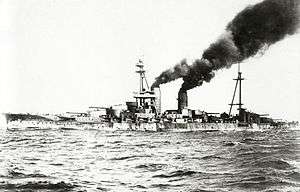
Originally planned to be the third Fusō-class battleship, experience gained in the construction of the Fusō class revealed a number of design issues, including weak armament and protection, which forced a redesign and new classification.
Ise was laid down at the Kawasaki Heavy Industries shipyard in Kobe on 5 May 1915, launched on 12 November 1916, and completed on 15 December 1917 and assigned to the Kure Naval District.
Completed too late for service in World War I, in the early 1920s, Ise participated in numerous patrols off the Siberia coast and in northern waters in support of Japan's Siberian Intervention against the Bolshevik Red Army.
On 12 April 1922, while at Yokohama, Ise hosted a delegation which included the Prince of Wales (the future Edward VIII), who was accompanied by his second cousin, the future Lord Mountbatten of Burma. From the mid-1920s through the late 1930s, Ise patrolled mostly off of the China coast.
In 1928-1929, Ise was rebuilt at the Kure Naval Arsenal, with its foremast increased in height in the distinctive "pagoda" style similar to Haruna. The fore funnel was fitted with a curved smoke cap, and a flying off platform for Yokosuka E1Y2 Type 14 floatplanes was fitted atop No. 5 main turret. Later, from 1930–1931, additional searchlights and a derrick was installed at the stern for handling floatplanes.
However, a more complete upgrade occurred from 20 November 1931 – 10 February 1932 at Kure Naval Arsenal, which involved shortening the mainmast top section, replacing all the 76 mm (3.0 in)/40 cal AA guns with eight Type 89 127 mm (5.0 in)/40 cal AA guns (4x2), and adding four Vickers Type 40 mm (1.6 in) AA guns (2x2). The shielded 140 mm (5.5 in)/40 cal guns from the forecastle deck were removed and a catapult and aircraft handling crane were fitted to the fantail. On 14 May 1933, a second catapult and three Type 90 seaplanes were added.
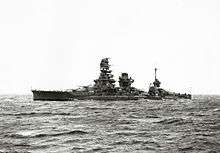
From 1 August 1935, Ise was drydocked at Kure Naval Arsenal and underwent an extensive reconstruction and modernization. The 24 mixed-fired (coal and oil) boilers were replaced by eight new Kampon oil-fired boilers and new Kampon geared turbines were fitted. Maximum speed increased to 25.4 kn (47.0 km/h; 29.2 mph) (25.21 kn (46.69 km/h; 29.01 mph) was reached during trials). The fore funnel was removed and stern lengthened by 7.62 m (25 ft). Anti-torpedo bulges were added and her six submerged torpedo tubes were removed. The maximum elevation of Ise's main battery (with the exception of the aftermost turret No. 6) was increased to 43°. Two forward 140 mm (5.5 in) casemate guns were removed, as was done with most other Japanese warships during this period, due to their exposed nature in heavy seas. The elevation of secondary guns was increased from 20° to 30° and range increased from 15,800 m (51,800 ft) to 19,100 m (62,700 ft). Four 40 mm (1.6 in) Vickers AA guns were replaced by 10 Type 96 twin 25 mm (0.98 in)/60 cal AA guns. The original catapult was replaced by a Kure Type No. 2 Mod. 5 catapult and the aircraft handling deck was extended. Reconstruction was completed by 27 March 1937.
Start of the Pacific War
Despite these efforts at modernization and upgrading, Ise was still considered obsolete by the start of the Pacific War due to her relatively slow speed, large crew, and short range, and never saw combat as a battleship. Ise participated in the attack on Pearl Harbor (albeit on a sortie from Hashirajima as far as the Bonin Islands) and pursued but did not catch the American carrier force that had launched the Doolittle Raid on 18 April 1942.
In May, Ise had an accident which flooded her No. 2 engine room. During repair work, Ise was fitted with one of the first experimental model Type 21 radar sets in the Japanese navy.
Reconstruction
To partially compensate for the loss of carrier strength at the Battle of Midway, Navy Aircraft Department began plans to convert the Ise-class battleships to full-sized aircraft carriers each carrying 54 planes. This concept was abandoned due to lack of time and resources and a hybrid battleship/carrier concept was adopted. Ise was dry-docked, and her aft No. 5 and No. 6 main turrets were removed and replaced by a hangar surmounted by a 70 m (230 ft) long flight deck and a "T"-shaped aircraft elevator. This was long enough to permit the launch of aircraft, but not their recovery. Two 25 m (82 ft) Model 11 catapults were installed on tall supports on the port and starboard sides forward of the flight deck. A collapsible derrick crane was fitted port abaft (two cranes were originally planned but installation was not carried out). It was realized that a single faulty aircraft engine could ruin the whole concept, so, to prevent jams, the deck was fitted with two rails to each catapult, 12 turntables, trolleys and tie-downs. Plans called for the new hangar to carry nine planes inside, with 11 on deck and one on each catapult. The new deck was covered with 200 mm (7.9 in) of concrete to compensate for the unbalanced condition created after removal of the aft armament. A 1 m (3 ft) thick layer of concrete was also poured around the main and reserve steering rooms and a 150 mm (5.9 in) horizontal armor cover was added.
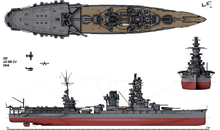
Additional anti-aircraft weapons were installed to better fight off aerial attack. The eight single 127 mm (5.0 in) DP guns were replaced with eight twin-mounts, and the Type 96 25 mm (0.98 in) AA guns were increased from 20 to 57 (including 19 triple-mounts). Type 21 air-search radar and two Type 22 surface-search radars were also installed. As modified, Ise could carry 22 aircraft. The operational concept envisioned Ise accompanying the Kido Butai (Carrier Strike Force), and launching its 11 Yokosuka D4Y2 Suisei ("Judy") dive bombers and 11 Aichi E16A Zuiun ("Paul") seaplanes that are capable of diving attacks to add another 44 bombers to the Strike Force. The Suisei had to land either on a conventional carrier or on land bases, whereas the E16A could be hoisted back aboard after landing near the ship by using a crane. Ise's final aircraft allowance called for 14 E16As and eight D4Y2s.
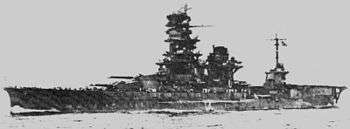
The rebuild was officially completed on 8 October 1943; however, as training with the new pilots was not completed by autumn 1944, Ise was never used in its new configuration in an operational mission. Its aircraft were offloaded to land bases, and Ise continued to be used as a pure battleship in the cover force.
Ise made a sortie to Truk in October 1943, conveying a detachment of the IJA 52nd Division and supplies.
In a refit in Kure in May 1944, 47 additional Type 96 25 mm (0.98 in) AA guns (12 triple, 11 single mount) were added, bringing the total to 104 guns. Two Type 2 IFF units were also installed. In July, two Type 13 air-search radar and an E27 Radar detector were installed. From the end of September 1944, six racks of 30-tube, 127 mm (5.0 in) anti-aircraft rocket launchers were added. The rockets had multiple incendiary shrapnel charges and a timed fuse.
Battle of Leyte Gulf and afterwards
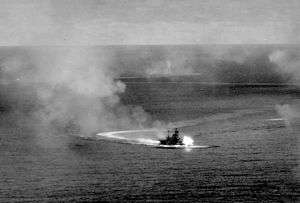
Ise was slightly damaged in October 1944 in the Battle off Cape Engaño, during which Ise's gunners shot down five of the 10 attacking dive bombers, suffering from one small hit on the No. 2 turret. Ise's anti-aircraft cover was ineffective, and by the end of the battle, USN aircraft had sunk the Japanese aircraft carriers Zuikaku, Zuihō, and Chitose and the destroyer Akizuki. Towards the end of the battle, in the fourth attack, Ise was attacked by 85 dive bombers. After 34 near misses, Ise's hull plates near the waterline ruptured and port boiler rooms were damaged; a bomb damaged the port catapult, and five crewmen were killed, with 71 wounded.
After returning to Japan, from 29 October, the aft catapults were removed to improve the firing arcs of the No. 3 and No. 4 turrets.
Ise was dispatched south to Lingga and Singapore in early 1945 for Operation Kita. On the approach to Singapore, Ise was slightly damaged by a naval mine. In Operation Kita, Ise, her sister ship Hyuga, and cruiser Ōyodo were loaded with critically needed strategic war supplies (oil, rubber, tin, zinc, and mercury) and evacuate 1,150 oil field personnel back to Japan. Ise arrived back safely in Moji on 19 February 1945, having evaded or escaped pursuit by twenty three Allied submarines along the way.
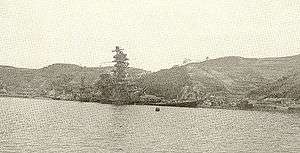
Final role
From 25 February 1945 until the surrender of Japan, Ise remained docked at Kure, without fuel or aircraft, and repainted in a camouflage olive green with splotches. The camouflage was not effective against USN Task Force 58 carrier-based aircraft on 19 March 1945, when more than 240 aircraft attacked Kure and Ise was hit by two bombs. Re-designated as a fourth-class reserve ship on 20 April, Ise was towed to Ondo Seto (between Kure and Kurahashijima) to serve as a floating anti-aircraft battery. She was attacked again on 24 July by 60 carrier-based aircraft, whose bombs hit the starboard bow, flight deck, main deck, No. 3 turret and bridge, killing Captain Mutaguchi, other bridge officers and around 50 crewmen. On 28 July, in another attack on Ise, she was struck by five 450 kg (1,000 lb) bombs dropped by F4U Corsairs from USS Hancock, and eleven more bombs dropped by other aircraft from TF 58. Ise listed starboard and sank in shallow water at 34°15′N 132°31′E / 34.250°N 132.517°E. She was removed from the Navy list on 20 November 1945.
Ise's underwater hulk section was for some time left where it was and she was scrapped without being raised by the Kure Dockyard of the Harima Zosen Yard from 9 October 1946 – 4 July 1947.
Notes
References
- Campbell, John (1985). Naval Weapons of World War II. Annapolis, Maryland: Naval Institute Press. ISBN 0-87021-459-4.
- Chesneau, Roger, ed. (1980). Conway's All the World's Fighting Ships 1922–1946. Greenwich, UK: Conway Maritime Press. ISBN 0-85177-146-7.
- Friedman, Norman (2011). Naval Weapons of World War One. Barnsley, South Yorkshire, UK: Seaforth. ISBN 978-1-84832-100-7.
- Hackett, Bob; Kingsepp, Sander; Ahlberg, Lars (2012). "IJN Ise: Tabular Record of Movement". Combinedfleet.com. Retrieved 15 June 2013.
- Jentschura, Hansgeorg; Jung, Dieter; Mickel, Peter (1977). Warships of the Imperial Japanese Navy, 1869–1945. Annapolis, Maryland: United States Naval Institute. ISBN 0-87021-893-X.
- Lengerer, Hans (September 2006). Ahlberg, Lars, ed. "Battleships Ise and Hyûga – Part I". Contributions to the History of Imperial Japanese Warships (Paper I): 4–30.(subscription required)(contact the editor at lars.ahlberg@halmstad.mail.postnet.se for subscription information)
- Lengerer, Hans (March 2007). Ahlberg, Lars, ed. "Battleships Ise and Hyûga – Part II". Contributions to the History of Imperial Japanese Warships (Paper II): 4–17.(subscription required)
- Lengerer, Hans (September 2007). Ahlberg, Lars, ed. "Battleships Ise and Hyûga – Part III". Contributions to the History of Imperial Japanese Warships (Paper III): 4–24.(subscription required)
- Lengerer, Hans (March 2011). Ahlberg, Lars, ed. "The Japanese 14"-Gunned Battleships: An Abstract of the Fusō and Ise Classes – Part I". Contributions to the History of Imperial Japanese Warships (Paper X): 5–42.(subscription required)
- Polmar, Norman; Genda, Minoru (2006). Aircraft Carriers: A History of Carrier Aviation and Its Influence on World Events. Volume 1, 1909–1945. Washington, D.C.: Potomac Books. ISBN 1-57488-663-0.
- Rohwer, Jurgen (2005). Chronology of the War at Sea, 1939–1945: The Naval History of World War Two. Annapolis, Maryland: Naval Institute Press. ISBN 1-59114-119-2.
- Silverstone, Paul H. (1984). Directory of the World's Capital Ships. New York: Hippocrene Books. ISBN 0-88254-979-0.
- Stille, Mark (2008). Imperial Japanese Navy Battleships 1941–45. New Vanguard. 146. Botley, Oxford, UK: Osprey Publishing. ISBN 1-84603-280-6.
- Whitley, M. J. (1998). Battleships of World War II. Annapolis, Maryland: Naval Institute Press. ISBN 1-55750-184-X.
External links
| Wikimedia Commons has media related to Ise. |
Coordinates: 34°15′20″N 132°30′58″E / 34.25556°N 132.51611°E